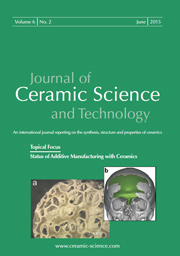Articles
All articles | Recent articles
Microstructure, Mechanical and Tribological Behaviour of TaC-SiC Composites
H. Chen1, Z. Wu1, W. Hai1,2,3, L. Liu1,2,3, F. Qin1, X. Sun1, T. Luo1, W. Sun1,2,3
1 College of Materials Science and Engineering, North Minzu University, Yinchuan, China, 750021
2 Key Laboratory of Powder Material and Advanced Ceramics, North Minzu University, Yinchuan, China, 50021
3 International Scientific and Technological Cooperation Base of Industrial Waste Recycling and Advanced Materials, North Minzu University, Yinchuan, China, 750021
received August 9, 2020, received in revised form October 26, 2020, accepted November 12, 2020
Vol. 12, No. 1, Pages 9-18 DOI: 10.4416/JCST2020-00021
Abstract
Owing to their high hardness and high-temperature strength, tantalum carbide (TaC) ceramics are being developed for cutting tools or anti-wear materials on moving parts. It is worth examining the mechanical strength and intrinsic abrasion resistance of TaC-based composites to promote their tribological applications. In this study, TaC-silicon carbide (SiC) composites with 5 – 40 vol% SiC were hot-pressed, and their microstructure, mechanical and tribological properties were investigated. The microstructure of the composites was observed with field emission scanning electron spectroscopy (FESEM) and high-resolution transmission electron microscopy (HRTEM). The composition of worn surfaces was analysed by means of X-ray photoelectron spectroscopy (XPS) and Raman spectrometry (Raman). The results showed that compared to pure TaC, the relative densities of the composites were enhanced greatly. With the increasing content of SiC, the hardness of the composites increased gradually, while the bending strength first increased then decreased. The TaC and SiC phases coexisted in the composites, and the interfaces were clean, crystallized, without transition layers. Coupled with SiC, the TaC-SiC composites showed good wear resistance, with wear rates of 10-5 mm3/N·m. The main wear mechanisms of the TaC-SiC/SiC pair were abrasion and tribo-chemical reaction.
![]() Download Full Article (PDF)
Download Full Article (PDF)
Keywords
Composites, wear resistance, carbides, wear mechanism
References
1 Zhang, X., Hilmas, G., Fahrenholtz, W.: Densification and mechanical properties of TaC-based ceramics, Mater. Sci. Eng. A, 501, 37 – 43, (2009), DOI: 10.1016/j.msea.2008.09.024.
2 Nino, A., Hirabara, T., Sugiyama, S., Taimatsu H.: Preparation and characterization of tantalum carbide (TaC) ceramics, Int. J. Ref. Met. Hard. Mater., 52, 203 – 208, (2015), DOI: 10.1016/j.ijrmhm.2015.06.015.
3 Hu, J., Luo, G., Zhang, J., Sun, Y., Shen, Q., Zhang, L.: Sintering mechanism and microstructure of TaC/SiC composites consolidated by plasma-activated sintering, Ceram. Int., 46, [3], 2624 – 2629, (2019), DOI: 10.1016/j.ceramint.2019.09.229.
4 Smith, C., Ross, M., Leon, N., Weinberger, C., Thompson, G.: Ultra-high temperature deformation in TaC and HfC, J. Eur. Ceram. Soc., 38, [16], 5319 – 5332, (2018), DOI: 10.1016/j.jeurceramsoc.2018.07.017.
5 Zhang, X., Hilmas, G., Fahrenholtz, W., Deason, D.: Hot pressing of tantalum carbide with and without sintering additives, J. Am. Ceram. Soc., 90, 393 – 401, (2007), DOI: 10.1111/j.1551 – 2916.2006.01416.x.
6 Pienti, L., Silvestroni, L., Landi, E., Melandri, C., Sciti, D.: Microstructure, mechanical properties and oxidation behaviour of TaC- and HfC-based materials containing short SiC fiber, Ceram. Int., 41, 1367 – 1377, (2015), DOI: 10.1016/j.ceramint.2014.09.070.
7 Liu, L., Ye, F., Zhang, Z., Zhou, Y.: Microstructure and mechanical properties of the spark plasma sintered TaC/SiC composites, Mater. Sci. Eng. A, 529, 479 – 484, (2011), DOI: 10.1016/j.msea.2011.09.079.
8 Liu, L., Geng, G., Hai, W., Chen, Y., Wu, L.: Effects of adding 5 – 20 mol% ZrC plus 5 mol% cu as a sintering aid on microstructure and mechanical properties of the TaC ceramics, Ceram. Int., 42, 16248 – 16254, (2016), DOI: 10.1016/j.ceramint.2016.07.156.
9 Liu, L., Vleugels, J., Huang, S., Wei, J., Wang, Y.: Strengthened interfacial bonding and its effects on fracture mode of TaC ceramics with the addition of B, J. Eur. Ceram. Soc., 40, 1067 – 1077, (2020), DOI: 10.1016/j.jeurceramsoc.2019.12.013.
10 Geng, G., Liu, L., Wang, Y., Hai, W., Sun, W., Chen, Y., Wu, L.: Microstructure and mechanical properties of TaC ceramics with 1 – 7.5 mol% si as a sintering aid, J. Am. Ceram. Soc., 100, 2461 – 2470, (2017), DOI: 10.1111/jace.14806.
11 Liu, L., Geng, G., Jiang, Y., Wang, Y., Hai, W., Sun, W., Chen, Y., Wu, L.: Microstructure and mechanical properties of tantalum carbide ceramics: effects of Si3N4 as a sintering aid, Ceram. Int., 43, 5136 – 5144, (2017), DOI: 10.1016/j.ceramint.2017.01.028.
12 Martı́nez, E., Wiklund, U., Esteve, J., Montalà, F., Carreras, L.: Tribological performance of TiN supported molybdenum and tantalum carbide coatings in abrasion and sliding contact, Wear, 253, 1182 – 1187, (2002), DOI: 10.1016/S0043 – 1648(02)00245 – 4.
13 Lv, Y., Li, J., Tao, Y., Hu, L.: High-temperature wear and oxidation behaviours of TiNi/Ti2Ni matrix composite coatings with TaC addition prepared on Ti6Al4V by laser cladding, Appl. Surf. Sci., 402, 478 – 494, (2017), DOI: 10.1016/j.apsusc.2017.01.118.
14 Ren, P., Wen, M., Zhang, K., Du, S., Zhang, Y., Chen, J., Zheng, W.: Self-assembly of TaC@Ta core-shell-like nanocomposite film via solid-state dewetting: toward superior wear and corrosion resistance, Acta Mater., 160, 72 – 84, (2018), DOI: 10.1016/j.actamat.2018.08.055.
15 Du, S., Zhang, K., Wen, M., Ren, P., Meng, Q., Hu, C., Zheng, W.: Tribochemistry dependent tribological behavior of superhard TaC/SiC multilayer films, Surf. Coat. Technol., 337, 492 – 500, (2018), DOI: 10.1016/j.surfcoat.2018.01.064.
16 Merwe, R., Sacks, N.: Effect of TaC and TiC on the friction and dry sliding wear of WC-6 wt% co cemented carbides against steel counterfaces, Int. J. Refract. Met. Hard Mater., 41, 94 – 102, (2013), DOI: 10.1016/j.ijrmhm.2013.02.009.
17 García, C., Martín, F., Herranz, G., Berges, C., Romero, A.: Effect of adding carbides on dry sliding wear behaviour of steel matrix composites processed by metal injection moulding, Wear, 414 – 415, 182 – 193, (2018), DOI: 10.1016/j.wear.2018.08.010.
18 Chao, M., Wang, W., Liang, E., Ouyang, D.: Microstructure and wear resistance of TaC reinforced Ni-based coating by laser cladding, Surf. Coat. Technol., 202, 1918 – 1922, (2018), DOI: 10.1016/j.surfcoat.2007.08.021.
19 Charpentier, L., Caliot, C. The impact of the oxidation on the optical properties of TaC, Sol. Energy Mater. Sol. Cells, 171, 16 – 23, (2017), DOI: 10.1016/j.solmat.2017.06.019.
20 Liu, H., Liu, L., Ye, F., Zhang, Z., Zhou, Y.: Microstructure and mechanical properties of the spark plasma sintered TaC/SiC composites: effects of sintering temperatures, J. Eur. Ceram. Soc., 32, 3617 – 3625, (2012), DOI: 10.1016/j.jeurceramsoc.2012.04.042.
21 Yu, Z., Yang, Y., Mao, K., Feng, Y., Wen, Q., Riedel, R.: Single-source-precursor synthesis and phase evolution of SiC-TaC-C ceramic nanocomposites containing core-shell structured TaC@C nanoparticles, J. Adv. Ceram., 9, [3], 320 – 328, (2020), DOI: 10.1007/s40145 – 020 – 0371-z.
22 Zhang, G., Liu, H., Zou, J., Wu, W., Liu, J.: Chemical reactions in the life cycle of ZrB2 ceramics (in Chinese), Chin. Sci. Bull., 60, 276 – 286, (2015), DOI: 10.1360/N972014 – 00466.
23 Berger, L., Eckart, L.: Grain size control in the synthesis of titanium and zirconium carbides, Met. Powder Rep., 51, [1], 39, (1997), DOI: 10.1016/s0026 – 0657(97)87065 – 8.
24 Ma, H., Zhang, G., Liu, H., Liu, J., Lu, Y., Xu, F.: Effect of WC or ZrC addition on thermal residual stresses in ZrB2-SiC ceramics, Mater. Design., 110, 340 – 345, (2016), DOI: 10.1016/j.matdes.2016.08.009.
25 Guo, J., Fu, H, Pan, B., Kang, R.: Recent progress of residual stress measurement methods: A review, Chin. J. Aeronaut., (2019), DOI: 10.1016/j.cja.2019.10.010.
26 Touloukian, S., Kirby, R., Taylor, E., Lee, T.: Thermal expansion -nonmetallic solids, IFI/Plenum, New York, NY, 1977. http://doi:10.1007/978 – 1-4757 – 1631 – 3.
27 Dai, F., Zhou, Y., Sun, W.: Segregation of solute atoms (Y, nb, ta, mo, and W) in ZrB2 grain boundaries and their effects on grain boundary strengths: A first-principles investigation, Acta Mater., 127, 312 – 318, (2017), DOI: 10.1016/j.actamat.2017.01.048.
28 Gong, J., Miao, H., Hu, B.: Compositional dependence of hardness of (Ce,Y)-TZP/Al2O3 composites, Mater. Sci. Eng.: A, 372, [1 – 2], 207 – 212, (2004), DOI:10.1016/j.msea.2003.12.
29 Leyland, A., Matthews, A.: On the significance of the H/E ratio in wear control: A nanocomposite coating approach to optimized tribological behaviour, Wear, 246, 1 – 11, (2000), DOI: 10.1016/s0043 – 1648(00)00488 – 9.
30 Hai, W., Ren, S., Meng, J., Lv, J.: Tribo-oxidation of self-mated Ti3SiC2 at elevated temperatures and low speed, Tribol. Lett., 48, 425 – 432, (2012), DOI: 10.1007/s11249 – 012 – 0036 – 3.
31 Hai, W., Zeng, J., Meng, J., Lv, J.: The tribological behaviour and tribochemistry of self-mated Ti3SiC2 in ethanol, Tribol. Lett., 50, 449 – 455, (2013), DOI: 10.1007/s11249 – 013 – 0142-x.
32 Yan, Y., Zhang, S., Fan, S., Han, W., Meng, G., Zhang, L.: Effect of changing incident wavelength on raman features of optical phonons in SiC nanorods and TaC nanowires, Solid State Commun., 126, 649 – 651, (2003), DOI: 10.1016/S0038 – 1098(03)00236 – 9.
33 Nakashima, S., Harima, H.: Raman investigation of SiC polytypes, Phys. Status. solid A, 162, 39 – 64, (1997), DOI: 10.1002/1521 – 396X(199707)162:1<39:AID-PSSA39>3.0.CO;2-L.
34 Hemley, R., Mao, H., Bell, P., Mysen, B.: Raman spectroscopy of SiO2 glass at high pressure, P. Phys. Rev. Lett. 57, 747 – 750, (1986), DOI: 10.1103/physrevlett.57.747.
35 Wada, N., Solin, S., Wong, J., Prochazka, S.: Raman and IR absorption spectroscopic studies on α, β, and amorphous Si3N4, J. Non-Cryst. Solid, 43, 7 – 15, (1981), DOI: 10.1016/0022 – 3093(81)90169 – 1.
Copyright
Göller Verlag GmbH


